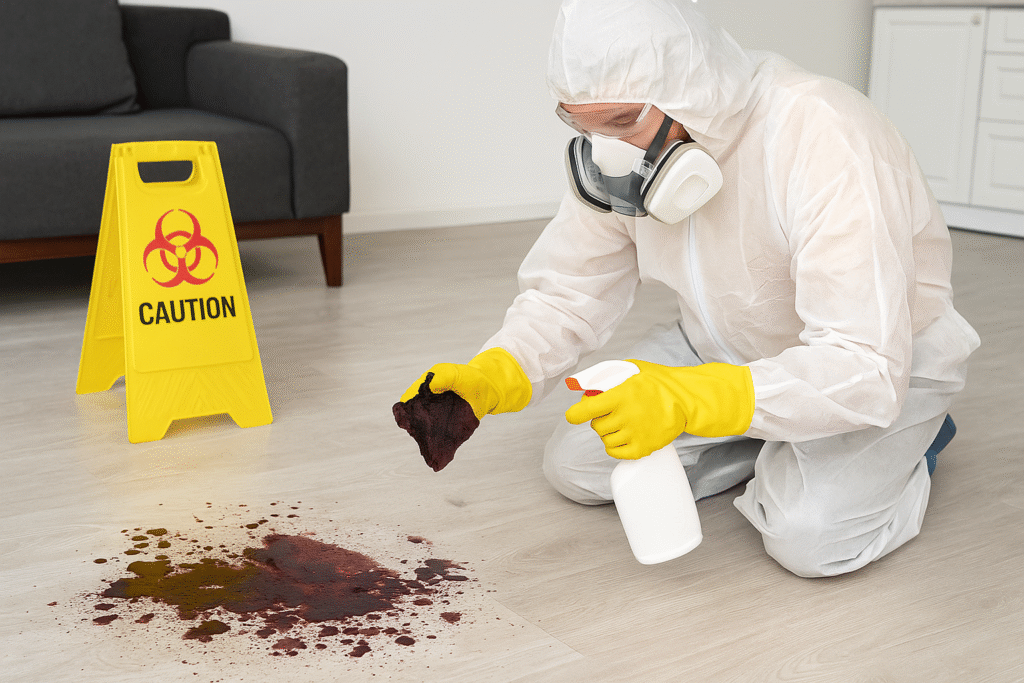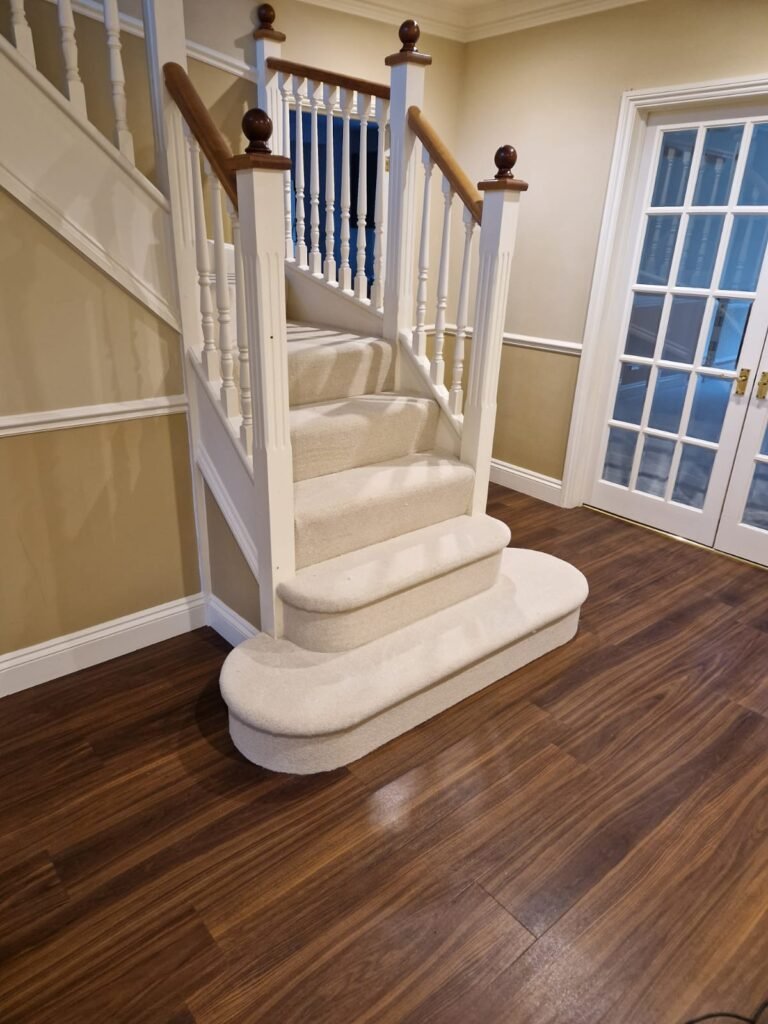Why Biohazard Cleaning is Essential After a Death at Home

When death occurs at home, families face serious health risks from bloodborne pathogens, toxic decomposition gases, and bacterial contamination. Discover why professional biohazard cleaning protects your family’s health and ensures safe property restoration.
Quick Summary
Death at home creates immediate biohazard risks that extend far beyond visible contamination. Professional cleanup protects families from dangerous pathogens while providing compassionate support during difficult times.
- Health Protection: Eliminates exposure to HIV, Hepatitis B/C, and deadly bacteria from bodily fluids
- Toxic Gas Removal: Neutralises dangerous decomposition gases that cause respiratory problems
- Complete Decontamination: Addresses contamination in porous materials like flooring and furniture
- Legal Compliance: Ensures proper waste disposal and regulatory adherence
Why This Matters for Property Managers and Facility Leaders
When death occurs in residential or commercial properties, property managers face immediate health and safety obligations. The study revealed a steady increase in “undefined deaths”, i.e., deaths of people found decomposed, between 1979 and 2020 for both sexes. This rising trend means property managers must understand their responsibilities for safe restoration and tenant protection.
Exposure to unattended death scenes without proper protection creates liability risks, regulatory violations, and serious health hazards for staff and future occupants. Professional biohazard cleaning ensures compliance with health regulations while protecting your organisation from legal consequences.
The Hidden Health Dangers of Death at Home
Bloodborne Pathogen Risks
Human blood can carry deadly diseases like HIV/AIDS, Hepatitis B, and Hepatitis C. When cleaning up blood it’s important to treat every blood spill as if the substance is infected. These pathogens remain viable in dried blood for extended periods, creating ongoing infection risks for anyone who encounters contaminated surfaces.
Decomposition fluids may carry bloodborne pathogens such as Hepatitis B, Hepatitis C, and HIV, posing a serious risk to anyone who comes into contact with the scene. Even small amounts of bodily fluids can harbour infectious agents that penetrate porous materials like carpets, wooden flooring, and furniture.
Toxic Decomposition Gases
The decomposition process produces toxic gases including hydrogen sulphide, methane, and ammonia, which can trigger headaches, nausea, and respiratory problems. These gases can settle into soft furnishings and carpets, making thorough decontamination complex and requiring specialised equipment.
The smell of decomposition caused by the realse of putrefactive gases like hydrogen sulfide and ammonia, is not just unpleasant but can cause nausea, headaches and respiratory problems. These toxic compounds can circulate through HVAC systems, contaminating areas far from the initial death scene.
Bacterial and Viral Contamination
Bacteria such as E. coli, Salmonella, and Staphylococcus can thrive in the fluids released by a decaying body, posing a risk to anyone who comes into contact with them. These dangerous microorganisms multiply rapidly in the moisture and organic matter present at death scenes.
Additionally, the moisture from decomposition creates ideal conditions for mould growth, leading to further respiratory health concerns. Mould contamination can persist long after initial cleanup attempts, causing ongoing health problems for occupants.
The Decomposition Timeline and Contamination Spread
Natural Body Processes
After death occurs, the human body begins decomposition within 24-72 hours, releasing bodily fluids and gases that contaminate surrounding environments. Once death occurs, the human body begins to decompose within 24 to 72 hours, depending on the surrounding environment. This decomposition process releases bodily fluids and gases that can seep into floors, furnishings, and even structural elements of the building.
Contamination Penetration
Decomposition fluids can soak into materials like carpets, mattresses and upholstery. This will lead to the growth of mold and harmful bacteria. The contamination often extends beyond visible areas, requiring professional assessment to identify all affected materials.
Decomposition fluids can seep into flooring, walls, and furniture, creating widespread contamination that extends far beyond the immediate area. Professional teams must assess not only visible contamination but also areas where bodily fluids may have penetrated porous materials.
Why DIY Cleanup Attempts Fail and Create Danger
Inadequate Protection and Equipment
Attempting cleanup without proper protection exposes individuals to these dangerous pathogens and contaminants. Professional cleanup teams use industrial-grade protective equipment and follow strict safety protocols to eliminate these health risks completely.
Standard household cleaning products cannot neutralise bloodborne pathogens or eliminate toxic decomposition compounds. Professional-grade disinfectants and specialised equipment are essential for effective decontamination.
Incomplete Contamination Removal
The gases produced during decomposition can carry harmful bacteria and pathogens into the air, leading to respiratory issues for those who breathe in these contaminants. Without proper air filtration and containment procedures, contamination spreads throughout the property during amateur cleanup attempts.
Psychological Trauma
Discovering someone who is deceased, particulary in an advanced state of decomposition, can be traumatic and distressing. Cleaning remnants of a tragic event can trigger intense emotional responses. These include grief, anxiety and PTSD.
While not a physical health risk, the psychological impact of encountering an unattended death scene can be profound. The trauma of discovering a decomposed body can lead to long-term mental health issues such as PTSD, anxiety, and depression.
Common Cleanup Problems and Dangerous Mistakes
Cross-Contamination Spread
Inexperienced cleanup attempts often spread contamination to previously clean areas. Without proper containment protocols, pathogens transfer from contaminated surfaces to clothing, tools, and other areas of the property.
Improper Waste Disposal
Bodily fluids and contaminated materials are classified as biohazardous waste and must be disposed of according to strict regulations. Placing contaminated materials in regular household waste violates health regulations and creates public safety risks.
Insufficient Odour Elimination
Professional equipment such as a ozone and fogging machine is required. Someone who does not have the necessary equipment will struggle to remove the odour with household chemicals. Decomposition odours penetrate building materials and require specialised treatment for complete elimination.
Incomplete Decontamination
Surface cleaning cannot eliminate contamination that has penetrated porous materials. Professional assessment identifies all affected areas, including subfloors, wall cavities, and HVAC systems that require decontamination or replacement.
Frequently Asked Questions
Who is responsible for cleaning up after a death at home? There is a common misconception that the after death clean up is handled by emergency responders. The after death cleaning is the responsibility of loved ones or the landlord. Professional biohazard cleaning companies provide this essential service with compassion and technical proficiency.
How long do bloodborne pathogens remain dangerous? The virus may remain infectious outside the body for up to two weeks. HIV, Hepatitis B, and Hepatitis C can survive in dried blood for extended periods, making any contact with contaminated surfaces potentially dangerous.
What makes professional cleanup different from regular cleaning? Professional biohazard cleanup uses industrial-grade protective equipment, specialised disinfectants, and follows strict safety protocols. Technicians secure and isolate the affected area to prevent cross-contamination and ensure complete pathogen elimination.
Can insurance cover biohazard cleanup costs? Many homeowner’s and commercial insurance policies include coverage for biohazard cleanup following traumatic events. Professional companies assist with insurance documentation and claims processing to minimise out-of-pocket expenses.
How long does professional cleanup take? Cleanup duration depends on contamination extent and affected area size. Simple cases may require several hours, while extensive contamination can take multiple days. Professional assessment provides realistic timeframes and restoration plans.
How Clean Scene Bio Ensures Safe Property Restoration
Clean Scene Bio provides certified biohazard decontamination services with compassion and technical precision throughout Oxford, Buckinghamshire, and London. Our CPD-accredited team understands the sensitive nature of death cleanup and delivers discreet, professional service during difficult times.
We implement comprehensive safety protocols that exceed industry standards, protecting both our technicians and your property’s future occupants. Our advanced equipment includes HEPA filtration systems, ozone generators, and industrial-grade disinfectants that eliminate all traces of contamination.
Our complete restoration process includes thorough assessment of contamination extent, secure containment to prevent spread, removal of all biohazardous materials, deep cleaning and disinfection with hospital-grade products, odour elimination using advanced neutralisation techniques, and final verification testing to confirm complete decontamination.
We work sensitively with families during their most difficult moments while ensuring complete regulatory compliance. Our documentation supports insurance claims and provides certification of safe restoration for your peace of mind.
Claire and Libby Priest founded Clean Scene Bio to provide professional death cleanup services that combine technical proficiency with genuine compassion. We understand that behind every cleanup is a family dealing with loss, and we approach each situation with respect and dignity.
Contact Clean Scene Bio for Compassionate Death Cleanup
Don’t expose your family to dangerous health risks during an already difficult time. Clean Scene Bio provides professional death cleanup services that ensure complete safety and peace of mind.
Call us now for immediate response: 07719 956929
Email: info@chalfontcarpetandflooringco.co.uk
Serving Oxford, Buckinghamshire, London & Beyond
Our certified technicians are available 24/7 for emergency response. We handle the technical aspects of safe restoration while providing the support and compassion your family needs during this challenging time.
